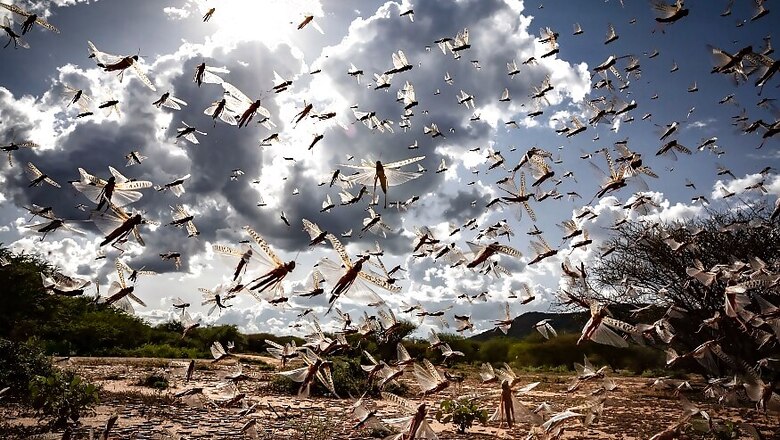
views
India is witnessing one of the biggest swarms of desert locusts in over 20 years and this is also the second consecutive year that locusts have swarmed from the western border to satiate their food needs. Swarms have not stopped entering into India from Pakistan, where they have bred in large numbers. What are these creatures? Are they harmful for humans? Why do they migrate in such large groups? News18 explains.
What are desert locusts and what are locust swarms?
Desert locust (Schistocerca Gregaria) is a species of short-horned grasshoppers that is largely found between Africa and the Indian sub-continent and in a few European and South American countries. Their life span is between three to six months and an adult locust can grow up to 2-3 inches in size.
The science behind locust swarms is fascinating and reflects one of their survival techniques. Like grasshoppers, at usual times locusts are solitary insects. Their breeding grounds are in deserts and they also lay their eggs in sand, but only when it is moist following spells of rainfall, said Mohammad Faisal, entomologist, Yamuna Biodiversity Park, Delhi.
“They move solitarily in deserts, walking. When the food dries up, they gather in large groups. When they gather around together, they rub the femurs of their hind legs and this leads to a release of serotonin. This strengthens their muscles, even the size of their mouth increases. The new muscle strength gives them the power to migrate together in search of food. They migrate in swarms as a survival technique, avoiding predators such as birds,” Faisal added.
How fast and how far can locusts fly?
Currently, the north-westerly winds are aiding the flight of locust swarms. The desert locusts can fly at a speed of 16-19kmph aided by favourable winds, the Food and Agriculture Organization of United Nations has said. Agriculture ministry officials said the swarms can fly up to 200 km with the help of winds and in normal times around 120-130km.
“In the past there have been some spectacular and very long distance swarm migrations, for example from North-West Africa to the British Isles in 1954 and from West Africa to the Caribbean, a distance of 5,000 km in about ten days in 1988. Solitary Desert Locust adults usually fly at night whereas gregarious adults (swarms) fly during the day,” the FAO has said.
What is the size of a locust swarm?
According to the FAO, locust swarms can vary from less than 1 sq km to several 100 sq kms in size. The swarms comprise between 40 million to sometimes 80 million locust adults in each sq m of swarm.
Where did the locusts come into India from and what is the role of climate change?
The range of desert locusts is found between Africa and Asia. In 2019, East African countries like Kenya saw frequent cyclones and heavy rainfall driven by climate change related warming of Arabian Sea. Scientists have said that these conditions proved to be ideal for breeding of locusts. Green vegetation and moisty sandy soils are favoured for breeding by locusts, the World Meteorological Organization said this February.
Apart from Africa, locust swarms also bred in Oman where there was heavy rainfall last year. The swarms have increased in numbers due to the rise in breeding and they moved to Iran and Pakistan in search of food. The swarms seen in India right now have travelled from Iran and Pakistan into Rajasthan. From Rajasthan, they have travelled as far as Panna in north eastern Madhya Pradesh and Vidarbha in Maharashtra.
How much food can a desert locust eat?
According to the FAO, a desert locust can eat its own weight in fresh food per day, which is about two grams every day. A swarm spread across one sq.km of 40 million locusts can eat one day’s food enough for 35,000 people and this calculation is based on a person eating an average of 2.3kg of food per day as per the United States Agriculture Department.
How are locust swarms killed?
Locusts are killed by spraying small doses of organophosphate chemicals. The control operations are carried out by the Ministry of Agriculture. Vehicle mounted sprayers, drones, tractor-mounted sprayers and fire fighter truck mounted sprayers have been deployed to spray the insecticides at night time. Malathion-96 is used to control locust populations and inhabitants of towns and villages are usually advised to move away from a day’s time to allow the effect of the chemical to not impact them adversely.
Besides, there is research going on to use non-chemical biological means to control locusts, according to FAO. “The current focus is primarily on pathogens and insect growth regulators. Thus far control by natural predators and parasites is limited since locusts can quickly migrate away from most natural enemies. Although giant nets, flamethrowers, lasers and huge vacuums have been proposed in the past, these are not in use for locust control. People and birds often eat locusts but usually not enough to significantly reduce population levels over large areas,” FAO said.
Do locusts bite humans?
No. Locusts cannot harm humans and neither do they bite humans. They prey only on crops and plants. But humans do eat locusts in Asian, Africa and South America.
When did India last record such a big swarm?
This is the second consecutive year that India has witnessed locust swarms. However, last year the swarms were largely restricted to Rajasthan and caused crop damage worth thousands of crores. According to the agriculture ministry data and entomologists, the last major swarm was seen in 1997 and before than in 1993. Mohammad Faisal of Yamuna Biodiversity Park said that scientific literature has records of a major locust plague that affected India between 1926 and 1931 and led to food shortage



















Comments
0 comment